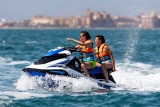And you, do you take photos or record videos? Some underwater photographers often achieve great results with video, and vice versa, though specialising in one technique or the other is more common. For beginners in underwater imaging, video is always simpler and more satisfying than conventional photography. Even the same video equipment, if digital, includes a photo function as standard.

Why Video?
- Because the automated features of video cameras are easier to use than those of photo cameras. Over time, you can learn small tricks with manual functions to improve the quality of your recordings.
- Because video cameras can operate in very low light. Even in the worst visibility conditions, you can still get good results.
- Because video allows you to see events and things in a more realistic way.
- Because with a bit of experience and the right knowledge, you can create your own stories. A computer and suitable editing software are all you need.
- Because after a dive, you can immediately review and assess the footage.
- Because screening the footage from a dive is a social event for those who took part. It’s a way to share great moments with friends.
- Because a video camera, once removed from its waterproof housing, can be used for any other family or personal event on land. It’s a sound investment.

What Features Should Our Video Camera Have?
This should be our first consideration. The answer will define the equipment and corresponding budget. The approximate budget (in Spain) for a new setup with a camera, waterproof housing, basic lighting kit (two 25 to 50-watt or 100-watt lights), and some accessories, depending on your goals, would be as follows:
- Do you simply want mementos of your dives? A basic setup will do the trick. Your camera and home TV will suffice for basic edits.
- Do you want to make short documentaries or fiction films, or even compete in underwater video competitions? A higher-quality setup is advisable.
The Camera
- Before buying a camera, check if the manufacturer sells a waterproof housing for it.
- It’s advisable to add a wide-angle lens for ambient shots (known as a 0.5× or 0.6× factor). Many housing manufacturers include these.
- It’s best to buy more than one Infolithium battery (with no memory effect), with the longest possible runtime.
- Some cameras feature colour transfer devices, known as CCD, similar to professional cameras. These are the highest-quality cameras but also the most expensive.

The Waterproof Housing
- Be very selective and ensure there’s a distributor in your country for your camera brand, with good after-sales service.
- Choose a housing that also offers manual options for its basic functions. Over time, you’ll learn to make the most of manual controls.
- Check the depth rating of the housing and whether it suits your diving style. Before placing the camera inside, dive with the empty housing to test its waterproofing.
Here are some components and accessories often included with a housing purchase. Verify what’s included in the net price:
- Flood sensor.
- Front lenses: one flat for normal and telephoto lenses, and one concave for wide-angle.
- Orange filter (internal or external) to restore warm tones to images.
- External monitor, preferably colour, to view recordings without using the viewfinder. This is especially useful for shots close to the seabed.
- Lights and articulated arms.
- Stabilising fin to reduce movement.
- Transport case or bag.
- Always request the instruction manual in English or a translated version from the distributor.

How to Get the Most Out of Your New Underwater Video Gear
You won’t become Spielberg overnight, but here are some tips to improve your videos:
- Try taking a video course, even a basic one. You’ll see quick improvements.
- Another option is to consult specialist books and watch lots of documentaries. Observe how shots are framed and the stillness of underwater footage.
- Attend underwater and documentary video festivals. This will help you gauge the standard and track your progress.
- Video, even as a simple keepsake, lets you tell stories—like what happens during a dive or a diving cruise on holiday. Get used to narrating everyday moments others can understand.
- Showing an entire dive is tedious. Select the best clips before screening. The final edit shouldn’t exceed 20 minutes.
- Stories should have a beginning, a middle where things happen, and an end.

In the Water
Without delving into technicalities, here are some practical tips for getting started underwater. Always record an extra 10 seconds at the start and end of each scene to simplify editing. Common mistakes when filming underwater are:
- Failing to keep a steady frame.
- Making shots too long.
- Moving the camera too quickly.
- Filming without a plan.
- Misusing the zoom.
Remember, you must counteract two types of movement: vertical (from your breathing) and horizontal (from finning). Use your waist and fins to compensate for both.
Avoid filming scenes with uneven lighting, as this causes harsh light changes.

Key Considerations
- Rinse your video gear with fresh water after each dive—don’t let saltwater dry on it.
- Underwater video significantly increases air consumption.
- No underwater shot, no matter how stunning, justifies harming marine life. Control your buoyancy.











